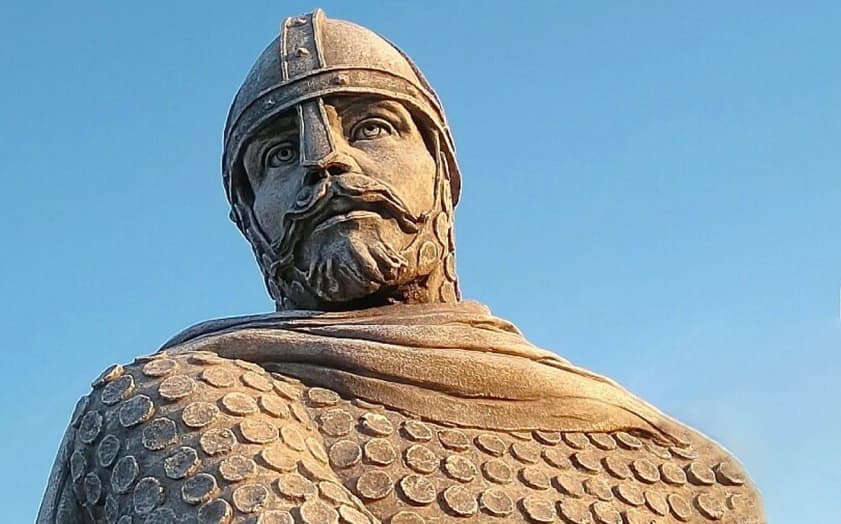If you are like me and understood very little about the history of Portugal, you have come to the right place. You might not know King Alfonso I of Portugal and why he is essential in understanding the Portugal of today.
Here I will discuss what I have learned about the rich history found in Portugal.
I found researching where you go is a much more enriching experience. When you finally arrive at your destination, you can surprise a local by saying, “Hey, ya, I know when this city was founded and by whom.”

Who was the First King of Portugal?
The Kingdom of Portugal emerged in the 12th century, connected with the process concerning the Christian reconquest of the Iberian Peninsula. At the same time, Christians had conquered all the territories occupied by the Moors southwards. Portugal, originally a county and a part of one of the most ancient Christian kingdoms of the Peninsula – Leão – demanded its independence in 1143.
What other names were King Afonso I known?
Many different names over the years also knew King Afonso. As a result, you may observe many of his various nicknames on many Portuguese buildings. So knowing the other names King Afonso I was known is essential to your understanding of Portuguese culture.
King Afonso I was also called Afonso Henriques, or the son of Henry. His battles with The Moors earned him the nickname the Conqueror by the Portuguese and El-Bortukali by the Moors.
- – The Conqueror; The Great; The Founder; The Father of the Nation
- – Afonso Henriques
Why is King Alfonso I important?
Due to endless fights and negotiations, the Pope awarded D. Afonso I, the First King of Portugal, in 1179. The Popes’ words granted Alfonso I the power to bring stability to this territory. In the eyes of the Christian world, that meant the birth of a new kingdom. The new Kingdom was located in the Iberian peninsula to defend against attacks from The Moors.
Who was King Alfonso I of Portugal?
In order to understand who King Alfonso I is, it is essential to begin at the roots of his life and then discuss the future crucial parts of his history. As a result, you will better understand his impact on Portuguese society.
Where was King Afonso I Birthplace?
King Afonso I, the future Portuguese king, was believed to be born in Guimarães, which was the most important political center of his parents.
However, there is a dispute about his birthplace and date. Viseu, Coimbra, Tierra de Campos or even Sahagún are popular theories of where he was born. Depending upon when someone believes Afonso I was born will tell you where they might think he was born.
Birthdate:
- 1106 = Tierra de Campos
- July 25th, 1109 = Coimbra
- August 1109= Viseu
The mystery of his actual birthplace and year presents another story. While the facts are unclear, one thing remains true; the Portuguese want to claim some part of Afonso’s history. Mainly if the narrative includes his birthplace.
However, let us go back to the Afonso I’s history. Afonso was the son of Teresa of León and Henry of Burgundy. They were the rulers of the County of Portugal in the Kingdom of León.

At this time, Portugal had not gained recognition as a Kingdom at this point in time. The County of Portugal resided in the Kingdom of León.
If you are like me, I was unaware of the Kingdom of Leon. The Kingdom of León’s southern border began near central Portugal and extended to the opposite side of the Iberian peninsula.
Death of Henry of Burgundy
Henry of Burgundy died in 1112. Thus Theresa ruled the county alone. The Portuguese nobility rallied around Afonso I because they were dissatisfied with Theresa’s romantic connection with Galician Fernando Pérez de Traba and his political power from the Kindom of León.
The Portuguese nobility revolted and defeated Theresa’s army at the Battle of São Mamede in 1128, and Afonso became the Count of Portugal soon afterward.

Renounced County of Portugal from Kingdom of León
In 1139, Afonso renounced the relationship with the Kingdom of León and established the independent Kingdom of Portugal.
The County of Portugal still needed diplomatic acknowledgment from the neighboring lands. The declaration would allow them recognition as a kingdom. At this time in history, it was maybe more important to gain recognition by the Catholic Church and the Pope.

Kingdom of Portugal Recognition
As you explore Portugal, you will notice many Monasteries and Catholic Churches. You will soon understand why Afonso I’s influence created such a religious influence.
In order for Portugal to become a kingdom, Afonso had to create a connection to the Catholic Church and the Pope.
In Portugal, he constructed several monasteries and convents. Therefore, he bestowed necessary privileges to religious orders to his family.
In 1143, he wrote to Pope Innocent II to proclaim himself the King of Portugal. Therefore, to persuade the Pope, he declared the church’s kingdom servants, and he would drive the Moors out of the Iberian Peninsula.
Notable Battles Against the Moors
Afonso, I vigorously campaigned against the Moors in the south. In 1139 he won a mighty triumph over the Moors at the Battle of Ourique. Later in 1147, Afonso conquered Santarém and Lisbon with help from men on their way to the Holy Land for the Second Crusade. He secured the independence of Portugal following a victory over León at Valdevez.
In 1179 the Catholic Church repaid these favors in the form of acknowledgment of Afonso as the King of Portugal. In the papal bull Manifestis Probatum, Pope Alexander III also acknowledged Afonso as King and Portugal as an independent kingdom with the right to conquer lands from the Moors.
Afonso died in 1185, and the succession of power to his son, Sancho I

Where was the First King of Portugal Buried?
The Monastery Santa Cruz in Coimbra is the first king of Portugal’s mausoleum. The first king, D. Afonso I, and his son D. Sancho I final resting places are inside the Monastery.
If you want to find the tombs of these kings, you must enter the alter. This area is often overlooked, so if you enter the Santa Cruz Church, take your time.
There are many other historical features to find in the Monastery Santa Cruz.
Who are Afonso I Descendents?
In 1146, Afonso married Mafalda, daughter of Amadeus III, Count of Savoy and Mahaut of Albon, appearing for the first time in May that year, confirming their royal charters.
Afonso, I had a total of six sons and five daughters. Some of these children were outside of his marriage with Mafalda. Afonso and Malfada had a total of 7 children together. Therefore, 3 of his sons and four daughters were born by Mafalda.
D. Alfonso I and Mafalda’s Children

They had the following children:
Henry (Born: March 5th, 1147 – 1155) Named after his paternal grandfather, Henry, Count of Portugal. He died when he was only eight years old. Despite being just a child, he represented his father at a council in Toledo at three.
Urraca (Born: 1148–1211) married King Ferdinand II of León and was the mother of King Alfonso IX. The subsequent marriage was annulled in 1171 or 1172. She retired in Zamora, one of the villas she had received as part of her arras. After her death, her burial occurred at the Monastery of Santa María in Wamba, Valladolid.
Teresa (Born: 1151–1218) was Countess consort of Flanders due to her marriage to Philip I and Duchess consort of Burgundy through her second marriage to Odo III.
Mafalda (Born: 1153 – after 1162) In January 1160, her father and Ramón Berenguer IV, Count of Barcelona, negotiated the marriage of Mafalda to Alfonso, future King Alfonso II of Aragon, who at that time was three or four years old. In the summer of 1162, King Ferdinand II of León convinced his widow, Queen Petronilla, to cancel the wedding plans with Mafalda. Mafalda died in her childhood at an unrecorded date.
Sancho (November 11th, 1154 – March 26th, 1211), the future King Sancho I of Portugal, baptism occurred with the name of Martin for having been born on the saint’s feast day.
John (Born: 1156 – August 25th, 1164)
Sancha (Born: 1157 – February 14th, 1166/67) was born ten days before the death of her mother, Sancha died before reaching the age of ten on February 14th, according to the death registry at the Monastery of Santa Cruz in Coimbra.
Children before Marriage
Before his marriage to Mafalda, King Afonso fathered his first son with Chamoa Gómez, daughter of Count Gómez Núñez and Elvira Pérez, sister of Fernando and Bermudo Pérez de Traba.
Afonso (1140–1207) Born around 1140, according to recent investigations, he is the same person as Fernando Afonso, who was the alferes-more of the king and later Grand Master of the Knights Hospitaller. The first recording of his presence in the court was in 1159. In 1169 he succeeded as alferes-for his half-brother, Pedro Pais da Maia, the legitimate son of his mother and Paio Soares da Maia.
Extramarital Offspring
The extramarital offspring of Elvira Gálter were:
Urraca Afonso. In 1185, her father gave her Avô, stipulating that this villa was inherited only by her children with her husband Pedro Afonso de Ribadouro (Pedro Afonso Viegas), grandson of Egas Moniz, which could indicate another previous or subsequent marriage. In 1187, she exchanged this villa for Aveiro with her half-brother, King Sancho. She died after 1216, the year she donated to the Monastery of Tarouca.
Teresa Afonso. In some genealogies, she appears as the daughter of Elvira Gálter, and in others as the daughter of Chamoa Gómez. Her first marriage was with Sancho Nunes de Barbosa with whom she had a daughter, Urraca Sanches, who married Gonçalo Mendes de Sousa, the father of Mendo Gonçalves de Sousa known as “Sousão”.[37] Her second husband was Fernando Martins Bravo, Lord of Bragança and Chaves, with no issue from this marriage.
King Afonso was also the father of:
Pedro Afonso (died after 1183) was the Lord of Arega and Pedrógão, mayor of Abrantes in 1179, alferes of King Afonso I between 1181 and 1183, Master of the Order of Aviz.
The Atypical Last Word
When you see Afonso Henriques written on a Portuguese building, you will better understand who they are referencing. Traveling around Portugal will become a more enriching experience with this new knowledge.
Our research has given you a brief history of the first monarch in Portugal. You learned about some of the major battles with the Moors. Therefore, you may realize this when walking around Coimbra, Lisbon, or another part of Portugal.
If you found the history of Afonso I, the first King of Portugal, informative, check out the other Portuguese History I’ve written.




Leave a Reply